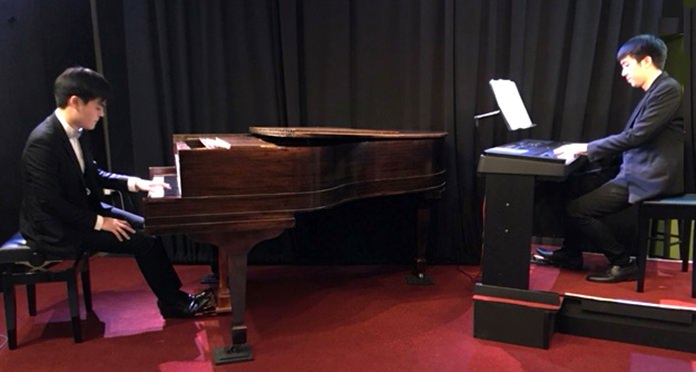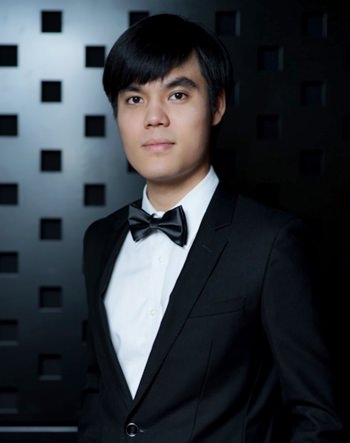
If you didn’t manage to get along to the recent concert at Ben’s Theater in Jomtien you missed an amazing evening. The star of the show was the young Thai prize-winning pianist Gun Chaikittiwatana, who presented a programme of music by Bach, Brahms, Chopin, Saint-Saëns, Debussy and Ravel.

The concert mostly featured music composed for the left hand. Some people think it’s an odd and remarkable thing that piano music exists for one hand. But there are hundreds of examples. In his book entitled One Handed: A Guide to Piano Music for One Hand the American pianist Donald Patterson identifies over two thousand such works. Interestingly, the vast majority of these pieces are for the left hand rather than the right, but I shall leave you to ponder this interesting statistic and form your own conclusions.
It wasn’t until the invention of the damper pedal in the nineteenth century that one-handed piano music became a reality. The sustaining pedal and the central sostenuto pedal opened new composing possibilities because they allowed notes to sound after the keys had been released.
Clara Schumann was one of the most distinguished German pianists of her time. When in 1877 she strained her right hand, Johannes Brahms came to the rescue with a left-hand arrangement of Bach’s famous Chaconne in D minor. Gun Chaikittiwatana opened his recital with this very work, which was more than coincidence because he too has been suffering from right-hand strain. “The reason I chose to perform a programme of mainly left-hand music,” explained Gun, “is because last year I experienced tension in the right-hand thumb. It limits the flexibility of the thumb significantly, though there’s been no pain. The doctors I consulted suggested that I should stop playing with right hand for a while. It’s now recovering through various physical therapies, but the actual cause of the problem remains unknown.”
Introducing the programme himself in English, Gun then gave a measured and impressive performance of the Bach, bringing out the melodic lines clearly with a beautiful sense of phrase. His playing reminded me of Debussy’s cryptic remark that “the music lies in the spaces between the notes”.
Gun then played Six Studies for the Left Hand written in 1912 by Camille Saint-Saëns. In the form of a Baroque suite, each movement presents different technical challenges. But there’s also a French lightness of touch, something in which Saint-Saëns excelled and which Gun brought out in his confident performance. One sensed the intense rhythmic vitality of music, the elegant phrasing, the rich expressive qualities and the touches of Gallic humour.
After the interval, Gun gave a poetic and thoughtful performance of Chopin’s dreamy Nocturne Op 27 No 2 and as usual played with a clear sense of phrasing and style. Gun is currently studying for his Bachelor degree in Piano Performance at the Mozarteum University in Salzburg. He has given acclaimed performances of Chopin’s First Piano Concerto, Tchaikovsky’s First Piano Concerto and Rachmaninoff’s Second Piano Concerto, all with the Thailand Philharmonic Orchestra. In 2013, Gun received First Prize and Soloist Award from the International Chopin Piano Competition in Asia.
Claude Debussy wrote his Twelve Piano Studies for Eight Fingers in 1915 and they’re not easy. Gun’s confident and technically assured performance of Etude No 6 was virtuosic. The main work of the concert was Ravel’s Piano Concerto for the Left Hand. The orchestral part was played on a Yamaha digital piano by Kant Lormsomboon, another young man of extraordinary talent. Kant began studying piano at the age of five and was later a prize-winner in many competitions in Thailand. Kant graduated with a Bachelor Honours Degree in Piano Performance at Chulalongkorn University. Incidentally, you can see Gun and Kant playing this Ravel concerto on YouTube as well as Gun’s performance of the complete set of Saint-Saëns studies.
Before Ravel began this concerto in 1929, he poured over the Studies for the Left Hand by Saint-Saëns, absorbing the composing techniques. The concerto was written for Austrian pianist Paul Wittgenstein whose right arm was amputated after he was wounded during WW1. He was incidentally, the elder brother of philosopher Ludwig Wittgenstein.
Ravel’s concerto is a powerful, dramatic work with subtle jazz influences and makes extraordinary demands on the soloist. The mysterious opening gradually builds tension and leads into a jaunty, galumphing melody which dominates the work. Gun played this effortlessly, accompanied by insistent repeated choral patterns played by Kant with impeccable precision on the second piano.
The concerto culminates in a monumental cadenza and Gun gave a heroic performance. The sound of the 100-year-old Stieff grand piano and the Yamaha digital piano blended surprisingly well. This two-piano version of the concerto was a musical revelation, because the complex orchestral parts were revealed in striking clarity. Gun and Kant gave a truly dazzling performance which displayed brilliant virtuosity, technical assurance, precise ensemble playing and splendid musicianship. To my mind, this was one of the finest musical performances that Ben’s Theater has ever presented.
 |
 |





